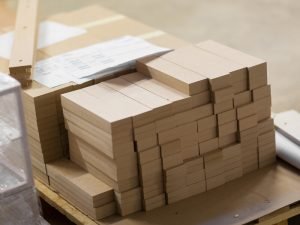There are several key steps in the production process of film faced plywood that are essential to ensure the quality, performance and appearance of the final product. The following is an overview of these key steps:
- Raw material selection and processing:
It is critical to select the right wood as the substrate. Typically, multiple layers of thin wood sheets or veneers are used, which need to be dried to achieve the appropriate moisture level and may also require pre-treatment such as chipping, screening and leveling. - Adhesive coating:
Apply the appropriate adhesive evenly on the wood substrate. The choice of glue depends on the type of film material and the desired product characteristics. The correct coating amount and uniformity directly affect the bond strength between the film material and the substrate. - Film material preparation:
Cut the film material according to the design requirements. The film material can be plastic film, paper veneer, metal foil or other synthetic materials, and may have been surface treated or printed with patterns. - Precision cutting and positioning:
The film material is cut using high-precision equipment and accurately placed on the glued substrate. This process has strict requirements on dimensional accuracy and positional accuracy, as any deviation may lead to quality problems in the finished product. - Pressurization and heating (if necessary):
For some types of laminating materials, a certain temperature and pressure need to be applied by a heat press to make the laminating material tightly bonded to the substrate. This step activates the adhesive and promotes a strong bond between the two. - Cooling and shaping:
The hot-pressed product must be cooled under controlled conditions to ensure that the laminated plywood maintains its shape and structural stability. This step is very important to prevent deformation. - Quality inspection:
The finished product must undergo a comprehensive quality control inspection, including tests for appearance defects, dimensional accuracy, bonding strength etc. Only products that meet all standards will be released to the market. - Packaging and storage:
Finally, qualified products will be properly packaged to protect them from damage during transportation and properly stored to maintain their best condition until distribution or use.
Ensuring the stability of film faced plywood is the key to ensuring that it maintains its performance and appearance for a long time in various application environments. The following are several main aspects that can effectively improve the stability of film faced plywood by taking corresponding measures:
- Select high quality raw materials
Wood substrate: Select high quality wood with uniform drying and moderate moisture content as the substrate to reduce deformation caused by humidity changes.
Laminating material: Select laminating materials with good physical and chemical stability, such as plastic films or paper finishes that are weather-resistant, UV-resistant, and not easy to fade. - Optimize production process
Selection and application of adhesives: Use environmentally friendly and strong adhesives, and ensure uniform coating, which helps to enhance the bonding strength between the laminating material and the substrate.
Pressing and heating treatment: For film faced plywood that requires hot pressing, processing under appropriate temperature and pressure conditions can make the laminating material closely bonded to the substrate, while activating the adhesive and improving the integrity of the product.
Cooling and shaping: After hot pressing, the product should be cooled naturally in a controlled environment or quickly cooled by a cooling device to ensure the stability of the product shape and structure. - Precise cutting and positioning
Use high-precision equipment to cut the laminated material and ensure that it is accurately attached to the substrate to avoid stress concentration problems caused by dimensional errors. - Strengthen quality control
Implement a strict quality inspection system during the production process, monitor every link from raw materials to finished products, and ensure that each batch of products meets the established standards.
The finished products are fully tested, including key indicators such as dimensional accuracy, bonding strength, and surface flatness. Only qualified products are allowed to be sold. - Reasonable storage conditions
Temperature and humidity control: Store the laminated plywood in an environment with relatively stable temperature and humidity, and avoid direct exposure to sunlight or humid places to prevent deformation or aging of the material.
Stacking method: Reasonably arrange the stacking method of the board to avoid bending or damage to the board due to excessive pressure. - Surface protection
Protective coating: According to the application scenario requirements, applying an additional protective coating such as clear paint or wear-resistant layer on the surface of the laminated plywood can increase its ability to resist external factors (such as scratches and chemical corrosion).
Edge sealing: Edge sealing of the board edges is not only beautiful, but also prevents moisture from entering the interior, thereby improving the stability of the entire board. - Consider environmental adaptability
When designing, consider the environmental conditions of the final use, such as indoor or outdoor, humid or dry areas, etc., and select materials and technologies suitable for the environmental characteristics to ensure that the film faced plywood maintains a good condition during its expected service life.

